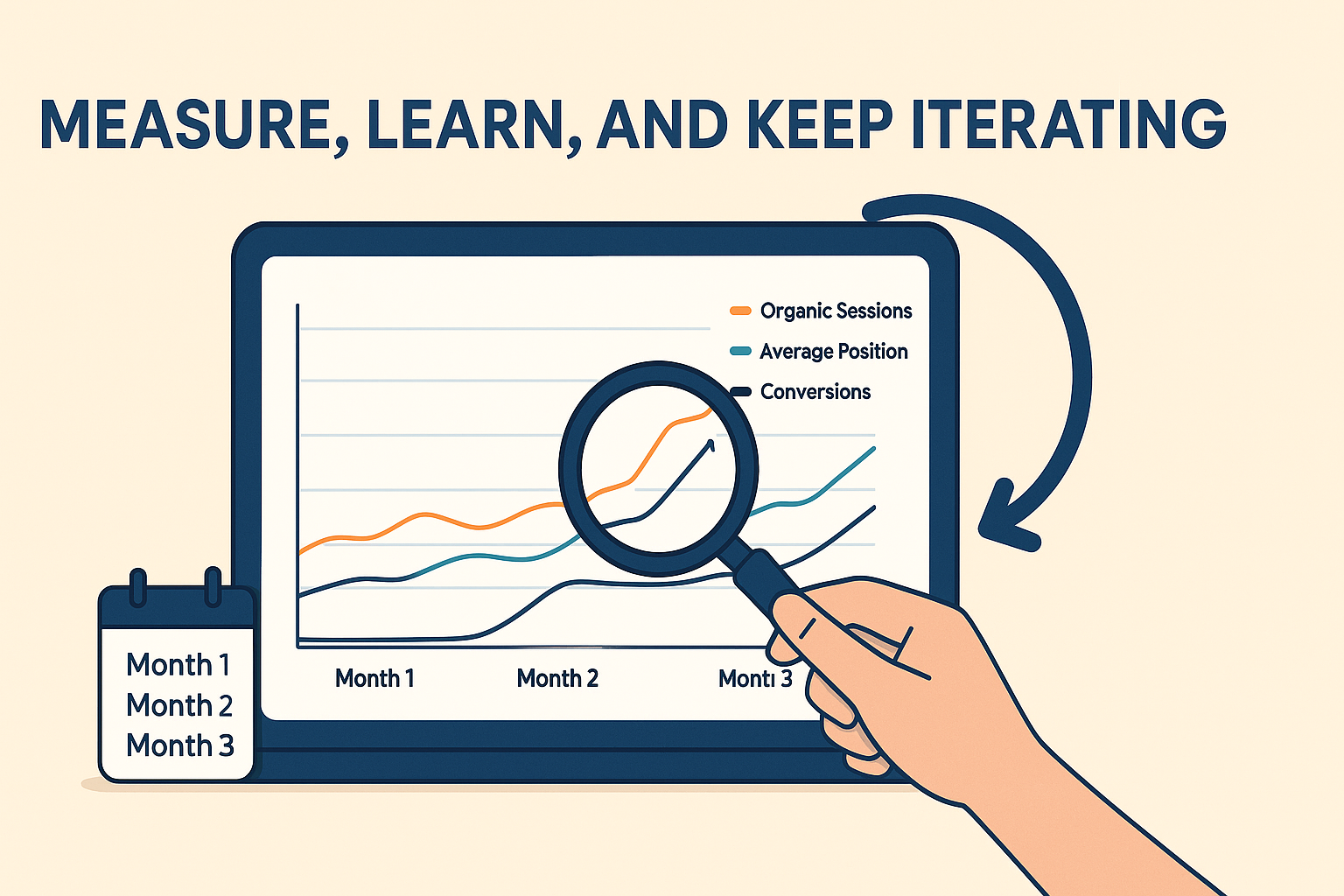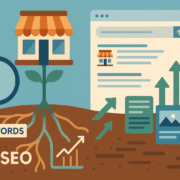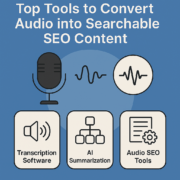Building an Effective SEO Strategy to Grow Your Small Business
Understand the Bigger Picture of SEO for Small Biz
Search‑engine optimization isn’t a hack or a growth‐hacking trick — it’s a long‑term relationship with the people you want to serve. When a potential customer types a question into Google, they’re effectively raising their hand and asking for help. Showing up at that exact moment, with a page that loads fast and answers the question clearly, builds trust before you ever speak to them. That trust is what makes organic traffic outperform many paid channels in conversion down the road.
Because small businesses rarely have the staff to run channel experiments in parallel, SEO often turns into the default “slow burn” project — something you dabble in on Friday afternoons. Resist that temptation. Treat organic visibility as a core product feature, not an optional marketing add‑on, and it will influence dozens of tiny decisions from copy tone to site structure. When everyone on the team understands that each blog post, product description, and help‑center article can rank, you’ll find optimization opportunities hidden in routine tasks. That collective awareness compounds over months into rankings your competitors can’t easily replicate.
Map Goals That Actually Matter
It’s easy to declare “we want more traffic” and call it a goal, but traffic that doesn’t align with revenue is just an expensive vanity metric. A smarter approach is to reverse‑engineer what a single organic visitor is worth to you. Start by calculating the percentage of organic users who join your email list, request a quote, or make a purchase. Multiply that by your average order value or lifetime value and you’ll have a realistic dollar target attached to every incremental click. Once that number is on the whiteboard, prioritization meetings get a whole lot easier.

Next, translate revenue targets into leading indicators you can influence every week. For example, if you know a 5 % uptick in organic sessions yields one extra sale per month, then boosting impressions for a handful of mid‑funnel keywords can suddenly look urgent. Setting quarterly checkpoints keeps the plan agile without turning it into a daily anxiety cycle. And remember, SEO isn’t all or nothing: small wins such as moving a page from position eleven to nine can double the clicks overnight. Celebrate those micro‑victories to keep motivation high when the bigger, slower milestones are still out of reach.
Get Inside Your Customers’ Heads with Smart Keyword Research
Keyword research doesn’t start with software; it starts with empathy. Sit down with a real customer — or at least read through support tickets — and note the exact phrases they use when explaining their pain points. Those raw sentences often map to long‑tail queries with low competition, making them perfect early targets. Once you’ve gathered a list, expand it by eavesdropping on forums, subreddits, and the “People also ask” box on Google. The goal is to build a vocabulary list that mirrors the way prospects think, not the way marketers talk.
When you’re ready to validate volume and difficulty, fire up a free keyword research tool and plug in your seed terms. Look beyond the top‑line metrics and scan the SERP itself: are the current ranking pages blog posts, product pages, or comparison articles? That context tells you what users expect to see. Finally, group related phrases into “content clusters”—collections of pages that share a theme and interlink naturally. Clustering prevents cannibalization and signals topical authority to Google without drowning visitors in near‑duplicate posts.
Shape Content That Hits Both Humans and Algorithms
Think of each piece of content as a mini product launch. You wouldn’t ship an app without a value proposition, onboarding flow, and bug fixes; your articles deserve the same care. Begin with a headline that promises a clear outcome, then fulfill that promise in the first two sentences so scanners understand why they should stay. Weave in primary keywords sparingly, as if they were seasoning; too much salt ruins the dish. Instead, focus on narrative flow — use stories, analogies, and quick examples to turn abstract concepts into something a small‑business owner can picture on their own site.

Multimedia isn’t just decoration; it’s a ranking factor disguised as user delight. Original screenshots, short explainer videos, or interactive tools reduce pogo‑sticking and improve dwell time, two signals Google watches closely. If creating assets from scratch sounds intimidating, repurpose what you already have: crop a webinar replay into a 45‑second GIF or convert a sales deck graphic into a blog illustration. Make sure every asset is compressed and lazy‑loaded so it doesn’t slow down the page. You can instantly see where you stand by testing your site speed and addressing any glaring slowdowns.
Technical Tune‑ups You Can’t Ignore
Even Pulitzer-quality prose won’t rank if bots cannot crawl it. Begin with a clean XML sitemap and a robots.txt file that doesn’t mistakenly block important directories. TMake sure each page has a unique title tag and meta description. If they’re the same, search engines can get confused and your click-through rates might drop. Also, check the canonical tags on similar pages — the wrong ones can hide your good content from search results. Having a weekly crawl report is an unglamorous task, but it detects 404 errors and redirect loops before they snowball into lost revenue.
Mobile usability is no longer a checkbox, it’s a starting point. Google’s mobile-first index examines what happens with a smaller screen first before it looks at all else. Test with your thumb, keep tap targets large, and skip intrusive interstitials that hide main content. Accessibility features like alt text and ARIA labels help all users, including contextually clueless search bots. Finally, think about structured data markup on reviews, prices, and FAQs. Those additional snippets are worth fighting for real estate in SERPs, sending competitors further down the fold.
Earn Links the Neighborly Way
Link building has a bad reputation because spammy tactics grabbed headlines a decade ago, but genuine editorial links remain one of the few ranking factors Google openly admits it can’t ignore. For small businesses, the sweet spot is local or niche relevance rather than sheer domain authority. Think chamber‑of‑commerce sites, community blogs, and suppliers who already have reason to mention you. Offer them something worth linking to—original research, a free calculator, or a case study featuring mutual success. If the resource genuinely helps their readers, the backlink request feels like a courtesy rather than a favor.
Cold outreach still works when it’s personal and concise. Skip the generic “Hey there” opener and reference a recent article or podcast episode to prove you’re not blasting form letters. Saving time matters, so before you hit send make sure you’re verifying email addresses to avoid bounces and protect your sender reputation. Pair that with a lightweight CRM or even a shared spreadsheet to track who’s been contacted and when to follow up. Consistent, polite persistence usually lands more links over three months than a one‑day blast ever will.
Measure, Learn, and Keep Iterating
The first time you open Google Analytics or Search Console, the sea of numbers can feel paralyzing. Start simple: track organic sessions, average position for your top ten pages, and conversions from organic traffic. Plot these three metrics on a shared chart every month; patterns will emerge faster than you think. When a page suddenly drops, check whether competitors refreshed their content or whether an algorithm update rolled out. Conversely, when something leaps upward, dissect the change and replicate it elsewhere before the edge fades.

Qualitative feedback rounds out the picture. Add a tiny “Was this helpful?” poll at the bottom of key articles and read every comment. Users will tell you exactly where they got stuck, which often correlates with exits in your analytics. Feed that insight back into content updates, then annotate the date in a simple changelog so you can tie ranking bumps to specific edits. Remember that SEO is a continuous loop, not a finish line. Each iteration compounds, turning a handful of steady climbs into a mountain of evergreen traffic over time.
Wrapping Up and Next Steps
SEO rewards consistency and penalizes randomness. If you approach it as a quarterly task, you will continue chasing competitors who integrate optimization into operations. But integrate keyword empathy into content strategy, hardwire technical hygiene into every release, and foster genuine relationships for backlinks, and you will build a moat that no paid ad spend can easily cross. The best part for small companies is that most of your competitors will never be able to stick it out for meaningful lift, giving you a clean path for those who are willing to continue showing up.
Choose one piece of this manual, and block out two concentrated hours during the week, and deliver a concrete improvement. Maybe it’s adding structured data, or crafting a lean product description into a narrative prospects cannot help but notice. Stack up those incremental victories, and see your organic dashboard become a flatline no more, and a rising tide. And when that initial sale comes from a keyword you studied months prior, you will see why Search Engine Optimization veterans are so annoyingly relaxed—it works quietly and persistently once it’s in your corner.
About the author:
Reza Manouchehri is a digital strategist who emphasizes strong brand storytelling in email newsletters. He has a knack for identifying unique selling points and transforming them into compelling campaign themes.




